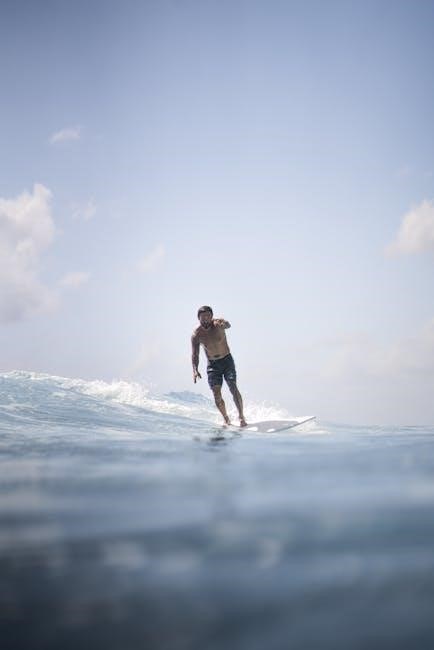Choosing the right surfboard length is crucial for optimal performance and stability in the water. This guide helps surfers of all levels understand how board length impacts their experience, offering insights into selecting the perfect size based on skill, body type, and wave conditions.
Why Surfboard Length Matters
Surfboard length plays a critical role in stability, buoyancy, and maneuverability, directly impacting a surfer’s performance. Longer boards provide more surface area, making it easier to catch waves and stay balanced, while shorter boards offer greater agility and control. For beginners, longer boards are ideal for learning, as they are more forgiving and easier to handle. experienced surfers often prefer shorter boards for advanced techniques and tighter turns. The right length ensures optimal paddling efficiency and wave-catching ability, making it essential to choose a board tailored to your skill level, body type, and surfing style. Proper length enhances overall performance and enjoyment in the water.
A Brief History of Surfboard Design
Surfboard design has evolved significantly over centuries, shaped by cultural, technological, and performance demands. Originating in ancient Hawaii, surfboards were crafted from wood, often reaching lengths of 10-14 feet for ease of riding waves. In the early 20th century, the introduction of fiberglass and foam revolutionized board construction, enabling shorter, lighter designs. The 1950s and ’60s saw the rise of modern surfboard shapes, with shorter boards emphasizing maneuverability. Today, surfboards vary widely in length, from longboards for stability to shortboards for high-performance surfing. This evolution reflects the pursuit of better performance, adaptability, and personal expression in the water.
Factors Influencing Surfboard Choice
Skill level, height, weight, fitness, wave conditions, and personal riding style are key factors in selecting the right surfboard, ensuring optimal performance and comfort in the water.
Skill Level and Surfing Experience
Your skill level and surfing experience play a significant role in determining the ideal surfboard length. Beginners benefit from longer, more buoyant boards, such as softboards or funboards, which offer stability and ease of catching waves. These boards typically range from 7 to 9 feet, providing the necessary floatation and forgiveness for those learning to balance and paddle. As surfers gain experience and improve their skills, they can transition to shorter boards, like shortboards or mid-lengths, which offer greater maneuverability and performance in various wave conditions. Experienced riders often prefer boards tailored to their specific style, whether it’s high-performance surfing or cruising on smaller waves.
Height, Weight, and Body Type
A surfer’s height, weight, and body type significantly influence the ideal surfboard length. Taller surfers typically require longer boards for stability, while shorter riders may prefer shorter boards for easier maneuverability. Weight also plays a role, as heavier individuals often benefit from boards with more volume to stay afloat. Body type further impacts this choice; for example, someone with a larger build might opt for a thicker, more buoyant board. Balancing these factors ensures optimal performance and comfort in the water, allowing surfers to catch waves and ride with confidence. Understanding how these attributes interact is key to selecting the right board.
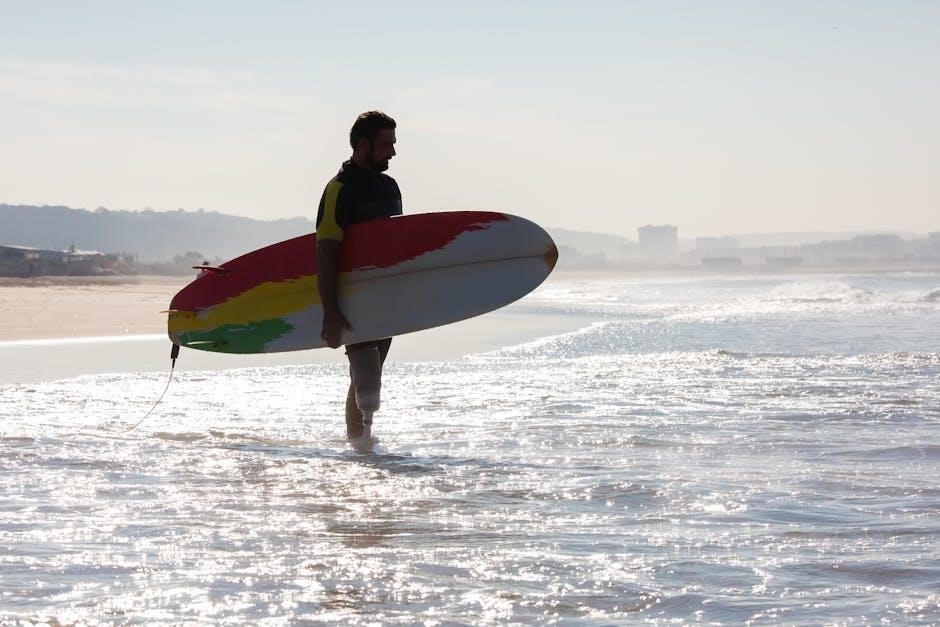
Fitness Level and Strength
A surfer’s fitness level and strength are crucial factors in choosing the right surfboard length. Surfers with higher strength and endurance can handle smaller, more maneuverable boards, as they can paddle efficiently and maintain control. Those with lower fitness levels may benefit from longer, more buoyant boards, which require less effort to catch waves and stay upright. Strength also influences pop-up speed and overall performance. Boards tailored to a surfer’s physical capabilities ensure better stability and control, making the surfing experience more enjoyable. Balancing fitness with board size is essential for maximizing progress and comfort in the water.
Wave Conditions and Surfing Location
Wave conditions and surfing location significantly influence the ideal surfboard length. In small, gentle waves, longer boards provide stability and ease of catching waves. For larger, faster waves, shorter boards offer better maneuverability and control. Surfing locations also play a role; beach breaks may favor longer boards for stability, while reef breaks might suit shorter boards for precision. Understanding the wave type and location helps surfers choose the right board length, ensuring optimal performance and safety. Matching board size to wave conditions enhances the overall surfing experience and allows riders to maximize their skills in various environments.
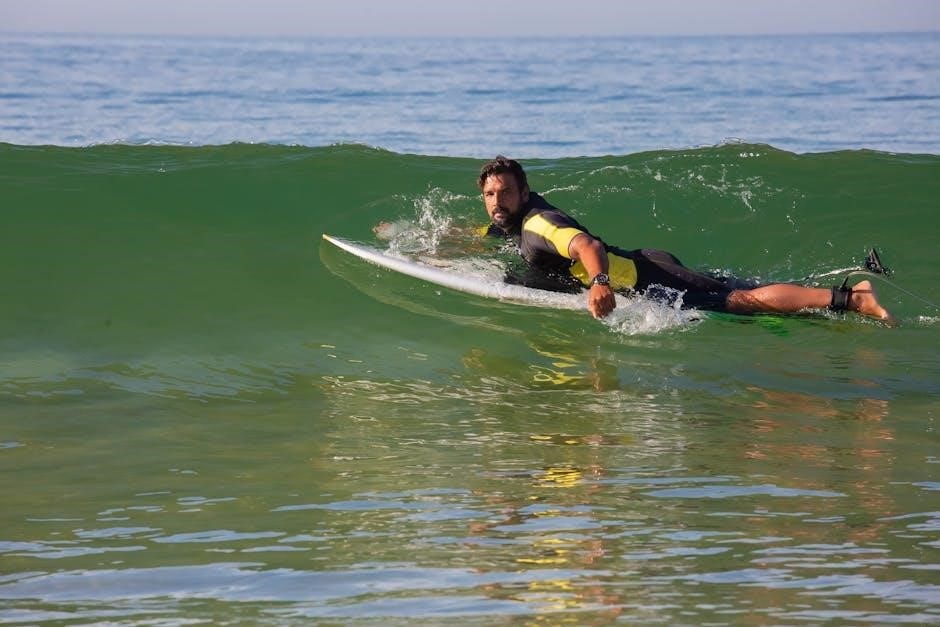
Personal Preference and Riding Style
Personal preference and riding style significantly influence surfboard length selection. Some surfers prefer the classic feel of longer boards for cruising, while others favor shorter boards for agility. Riding style, such as carving or nose-riding, also impacts length choice. Surfers prioritizing speed and stability may opt for longer boards, while those seeking maneuverability and trick performance prefer shorter ones. Individual preferences for stance, turning radius, and overall surfing experience further tailor the ideal length. Ultimately, aligning board length with personal style ensures a more enjoyable and responsive surfing experience, allowing riders to express their unique approach to catching waves.

Different Types of Surfboards
Surfboards vary in length, shape, and design, catering to diverse preferences and performance needs. From longboards to shortboards, funboards, softboards, and mid-lengths, each type offers unique riding experiences.
Longboards: Characteristics and Benefits
Longboards, typically ranging from 8 to 14 feet in length, are ideal for beginners due to their stability and ease of catching waves. Their rounded noses and high volume provide excellent buoyancy, making them perfect for smaller waves and casual cruising. Experienced surfers also appreciate longboards for their classic, flowing maneuvers and smooth turns. The added length enhances paddle power and speed, allowing riders to glide effortlessly. Longboards are versatile, suitable for both learning and advanced techniques, making them a favorite among surfers seeking a traditional, enjoyable experience in various wave conditions.
Shortboards: Performance and Maneuverability
Shortboards, typically ranging from 5 to 7 feet in length, are designed for high-performance surfing. Their compact size allows for sharp turns, quick direction changes, and precise control, making them ideal for experienced surfers. With a focus on maneuverability, shortboards excel in faster waves and hollow conditions, enabling dynamic and aggressive surfing. Their narrower noses and rounded or squashed tails enhance responsiveness, while their lower volume requires more skill to paddle and stay afloat. Shortboards are perfect for intermediate to advanced riders seeking speed, agility, and the ability to carve through waves with precision and style.
Funboards: Versatility for All Levels
Funboards, typically ranging from 7 to 9 feet in length, offer a versatile option for surfers of all skill levels. Their rounded noses and softboard variations make them ideal for beginners, while their maneuverability appeals to more experienced riders. Funboards provide excellent stability and buoyancy, making it easier to catch waves and stay afloat. They perform well in a variety of wave conditions, from small waves for cruising to larger waves for carving. Their moderate volume and length strike a balance between the ease of longboards and the agility of shortboards, making them a great choice for those transitioning between board types or seeking an all-around surfing experience.
Softboards: Safety and Durability
Softboards are a popular choice for beginners and surf schools due to their safety features and durability. Constructed with foam materials, these boards are soft to the touch, reducing the risk of injuries from impacts. Their rounded noses and smooth edges further enhance safety, making them ideal for learning environments. Softboards are generally more resistant to dings and cracks compared to fiberglass or carbon fiber boards, requiring less maintenance. They also tend to have more volume, which helps with buoyancy and stability, allowing new surfers to catch waves more easily. This combination of safety, durability, and performance makes softboards an excellent option for those starting their surfing journey.

Mid-Length Boards: A Balance Between Styles
Mid-length boards, typically ranging from 6.4 to 8 feet, offer a versatile balance between the stability of longboards and the maneuverability of shortboards. These boards are ideal for surfers seeking a transitional option between softboards and shorter, performance-oriented models. Their moderate length provides ample buoyancy and ease of catching waves, while still allowing for responsive turns. Mid-length boards are particularly suited for intermediate surfers looking to refine their skills or for those who prefer a forgiving yet engaging ride. Their rounded noses and soft rails enhance stability, making them a great choice for progressing surfers or those who enjoy cruising in various wave conditions.
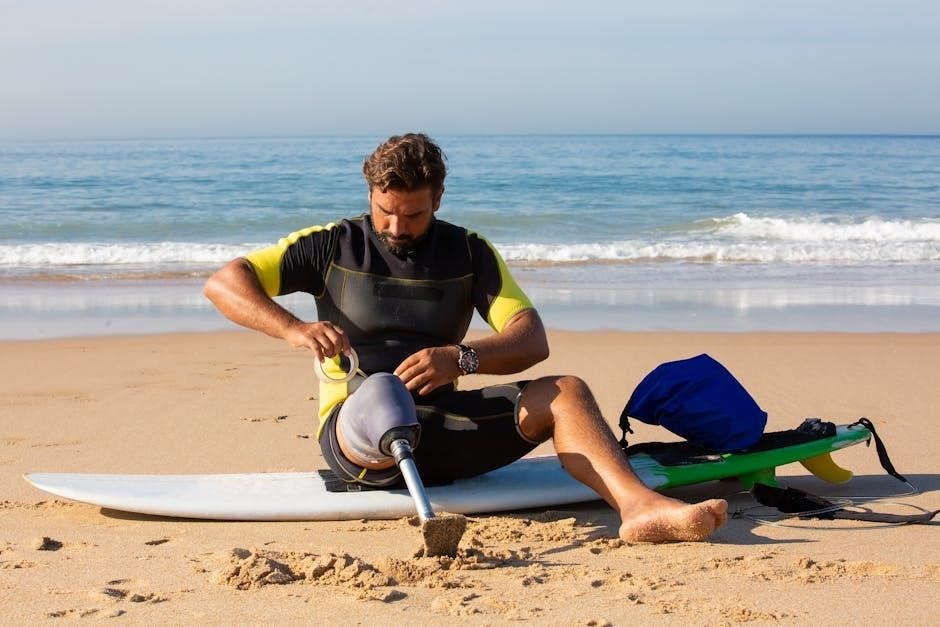
How to Choose the Right Surfboard Size
Choosing the right surfboard size involves matching rider height, weight, skill level, and wave conditions to ensure optimal performance, stability, maneuverability, and ease of use.
Determining Ideal Length Based on Rider Attributes
Surfboard length should align with a rider’s height, weight, and skill level for optimal performance. Taller or heavier surfers often benefit from longer boards for stability, while shorter or lighter riders may prefer shorter boards for easier maneuverability. Beginner surfers typically start with longer, more buoyant boards to catch waves effortlessly, while advanced riders can opt for shorter boards for better agility. Fitness and strength also play a role, as longer boards require more effort to handle. Balancing these attributes ensures the right size for comfort, control, and progression in surfing. Proper sizing enhances the overall surfing experience and aids in mastering new skills.
Understanding Volume and Its Impact on Performance
Volume is a critical factor in surfboard performance, directly affecting buoyancy and floatation. A higher volume board provides more buoyancy, making it easier for surfers, especially beginners, to catch waves and stay afloat. Conversely, lower volume boards offer greater maneuverability, ideal for advanced surfers seeking quicker turns and tighter control. The distribution of volume across the board’s length and thickness also impacts stability and speed. Thicker boards with volume concentrated in the center enhance stability, while streamlined boards with volume towards the ends promote speed and agility. Balancing volume with length ensures optimal performance tailored to a surfer’s skill level and riding style.
Progression: From Bigger Boards to Smaller Models
Surfers often start with larger, more buoyant boards to build confidence and skill. As they progress, transitioning to smaller models enhances performance. Bigger boards, like funboards or longboards, provide stability and ease of catching waves, making them ideal for beginners. Gradually moving to shorter, more maneuverable boards allows surfers to refine their techniques, improve speed, and execute sharper turns. This progression ensures a natural evolution in skill development, balancing floatation and control. Smaller boards, such as shortboards, demand more precision but offer greater responsiveness, catering to advanced riders seeking thrilling rides in varied wave conditions. Tailoring board size to skill level fosters continuous improvement and adaptability in the water.
Considering the Rider’s Experience and Goals
A rider’s experience and goals significantly influence surfboard selection. Beginners benefit from larger, stable boards that make catching waves easier, while experienced surfers may prefer shorter, more responsive boards for advanced maneuvers. Intermediate riders often transition to smaller boards as their skills improve, seeking a balance between stability and performance. Wave conditions also play a role, as smaller waves may require longer boards for easier wave catching, while powerful waves suit shorter, more maneuverable boards. Ultimately, the rider’s goals—whether to improve, perform tricks, or simply enjoy cruising—guide the choice of board length and volume, ensuring the best match for their surfing aspirations and progress.
Maintenance and Care of Your Surfboard
Proper maintenance ensures your surfboard’s longevity and performance. Regular cleaning, storing in a cool, dry place, and checking for dings are essential. Waxing regularly enhances grip.
Proper Storage to Prevent Damage
Proper storage is essential to maintain your surfboard’s condition and prevent damage. Store your board in a cool, dry place away from direct sunlight to avoid warping or delamination. Use a high-quality board bag to protect it from dings and scratches. Avoid leaning the board against hard surfaces or sharp objects. If storing for an extended period, ensure the board is clean and dry to prevent mold or mildew. Keep it flat to maintain its shape and prevent warping. Regularly inspect the board for damage and address issues promptly. Proper storage ensures your surfboard remains in optimal condition for future use.
Cleaning Techniques for Optimal Performance
Regular cleaning is vital to maintain your surfboard’s performance and longevity. Start by rinsing the board with fresh water after each use to remove salt, sand, and debris. Use a mild soap or surfboard-specific cleaner and a soft sponge to scrub the surface, paying attention to the deck and rails. Avoid harsh chemicals or abrasive materials that could damage the finish. For stubborn wax residue, use a wax comb or scraper gently. Rinse thoroughly and dry the board with a microfiber towel to prevent water spots. Regular cleaning prevents buildup, ensures proper wax adhesion, and keeps your board looking its best.
Repairing Dings and Cracks
Repairing dings and cracks in your surfboard is essential to maintain its integrity and performance. Start by assessing the damage to determine the best approach. For minor dings, clean the area with a solvent and apply a small amount of resin, allowing it to dry completely. Sand the repaired area smoothly to blend it with the surrounding surface. For deeper cracks or delamination, professional repair is often necessary to ensure structural integrity. Addressing damage promptly prevents further deterioration and extends the life of your board. Regular inspections and timely repairs are key to keeping your surfboard in optimal condition for years of reliable use.
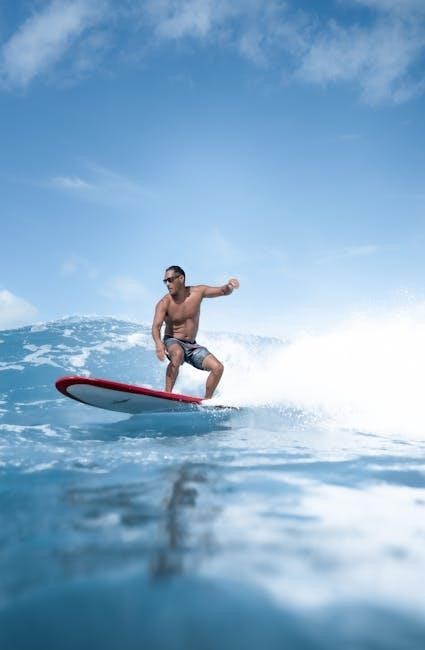
The right surfboard length enhances performance and stability. Consider skill level, body type, and wave conditions to make an informed choice for an optimal surfing experience.
When selecting a surfboard, prioritize factors like skill level, height, weight, and wave conditions. Longer boards offer stability and ease of catching waves, while shorter boards provide maneuverability. Volume plays a crucial role in buoyancy, with higher volumes suiting beginners and lower volumes benefiting experienced surfers. Consider personal preferences, such as riding style and performance goals, to narrow down options. Wave type and location also influence board choice, as certain shapes excel in specific conditions. Ultimately, aligning the board’s dimensions with your attributes and surfing objectives ensures the best experience. This guide simplifies the process, helping you make an informed decision tailored to your needs.
Final Tips for Choosing the Perfect Board
Test a board before committing to purchase by renting or demoing. Consider your current skill level and future goals to ensure the board grows with you. Seek advice from experienced surfers or shop experts for personalized recommendations. Prioritize volume and length based on your needs, balancing stability with performance. Don’t rush the decision—take your time to find the right fit. Remember, the ideal board aligns with your surfing style, local wave conditions, and personal preferences. By combining research, practical experience, and expert insights, you’ll make an informed choice that enhances your surfing journey and keeps you stoked in the water.
